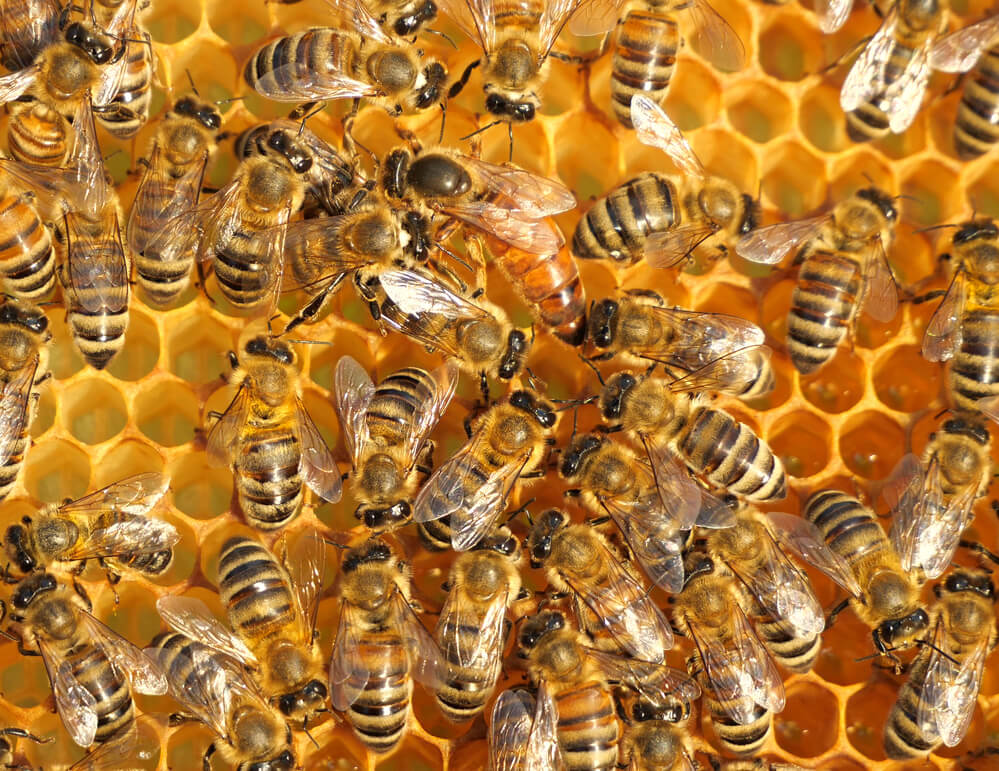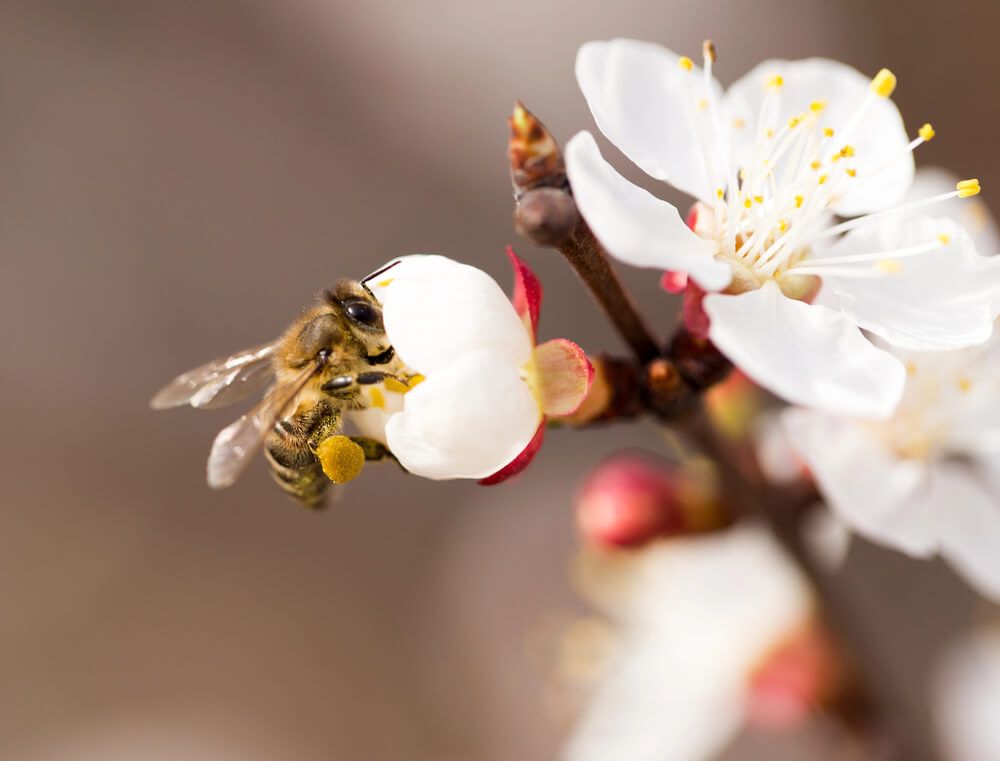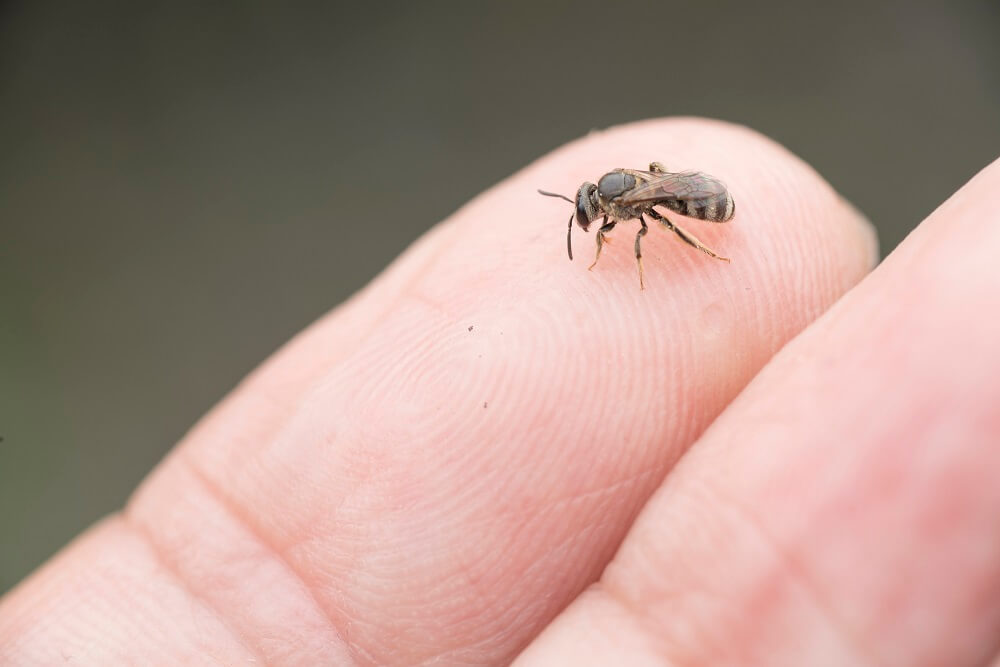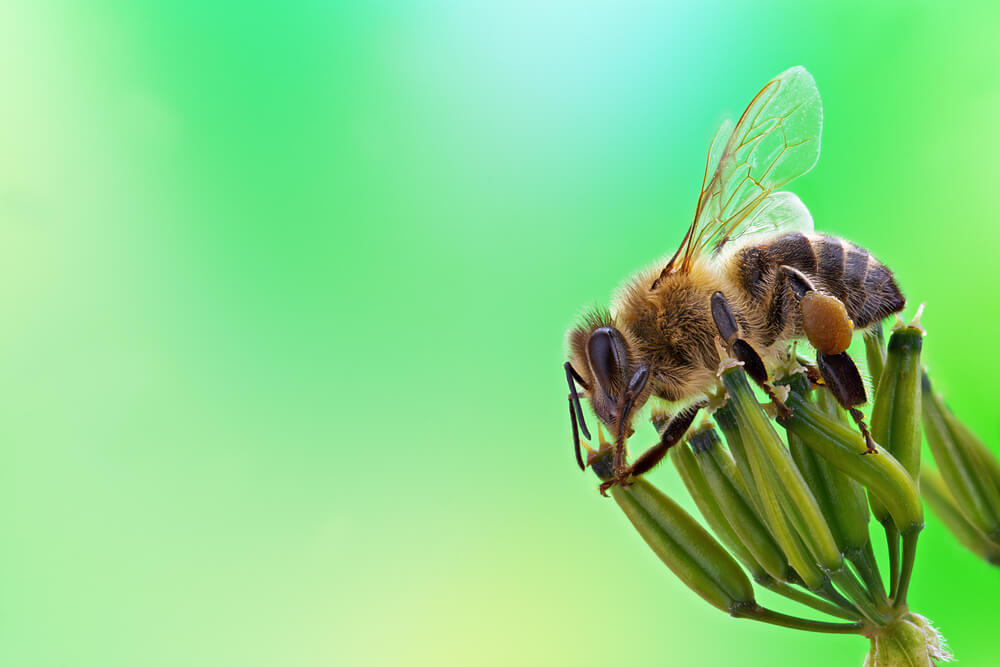What Are Bee Families Called?
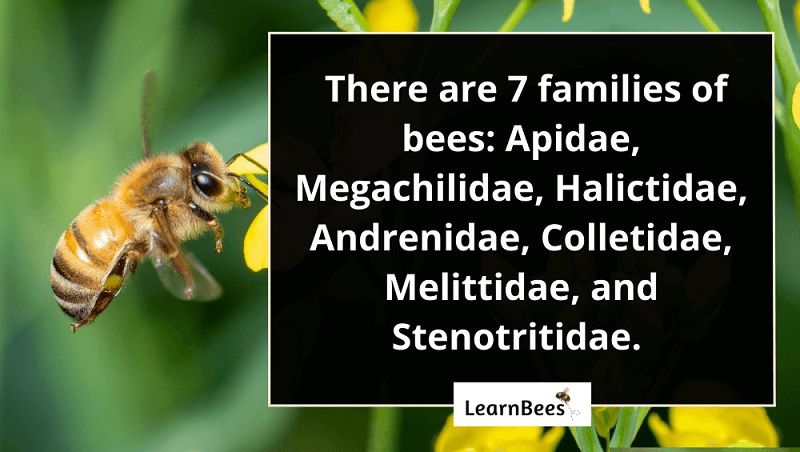
There are seven families of bees:
- Apidae
- Andrenidae
- Colletidae
- Halictidae
- Megachilidae
- Melittidae
- Stenotritidae
The Apidae is the largest bee family, with roughly 6,000 different bee species in it. For example, bumble bees, honey bees, and carpenter bees all belong to the Apidae bee family.
The Andrenidae contains solitary ground-nesting bees. There are roughly 2,700 bee species that belong to this family.
As their name suggests, ground-nesting bees dig holes in the dirt to build their nests. As such, these bees are often nicknamed “ground bees” or “mining bees.”
Bees that belong to the Andrenidae family are typically the first to emerge in the spring.
The Colletidae are solitary bees that makeup around 2,000 bee species. Bees belonging to the Colletidae family are nicknamed “plasterer bees” or “cellophane bees.”
They’ve earned their nickname due to their nesting habits. They produce a silky cellophane material from their abdomen, which they use to line the walls of their nests. It helps make the nest waterproof and fungal-resistant.
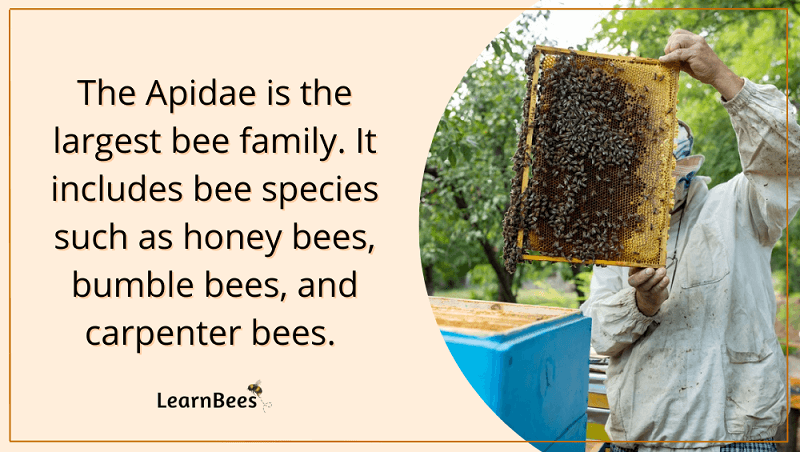
Many Colletidae look a lot like mining bees, and they even fly around at the same time in early spring.
Other types of bees belong to the Colletidae family, like the crepuscular bees. Crepuscular bees are called crepuscular because they forage at night when the moon is present.
The Halictidae are a group of about 3,500 bee species. They’re all ground-nesting bees that have different levels of sociality. Some bees live in social families known as colonies, while others live alone.
Halictidae are often called “sweat bees” because some species are attracted to the salt in human sweat. Many Halictidae are tiny bees that have a metallic green or blue coloring.
Unlike bumble bees and honey bees, bees that belong to the Halictidae family are usually very timid and fly away if you get too close.
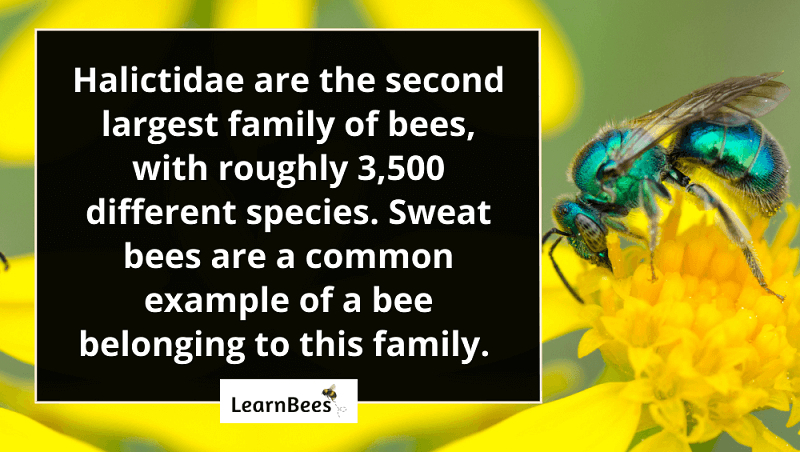
The Megachilidae are solitary bees with large heads and large jaws (mandibles), which they use for nesting. For example, leafcutter bees use their powerful mandibles to chew through leaves to build their nesting cavities. There are roughly 3,000 bees in this family.
Unlike other bee species, Megachilidae bees carry pollen under their abdomen instead of on their hind legs.
The Megachilidae has the greatest diversity of nesting habits among all families. Different species build their nests using different materials, including leaf pulp, mud, resin, gravel, wood pulp, or plant fibers.
The Melittidae is a very small family of around 200 bee species. They’re typically small to medium-sized solitary bees that nest in the ground.
This short-tongued bee family is known for eating more than pollen and nectar. For example, a handful of species feed their offspring floral oils and pollen instead of just pollen and nectar.
The Stenotritidae is the smallest family of bees, with only around 21 species. Stenotritidae is ground-nesting solitary bees that are only found in Australia. These bees are closely related to Colletidae.
They’re very large, hairy bees that are known as fast fliers.
How Many Bees Are in the Family?
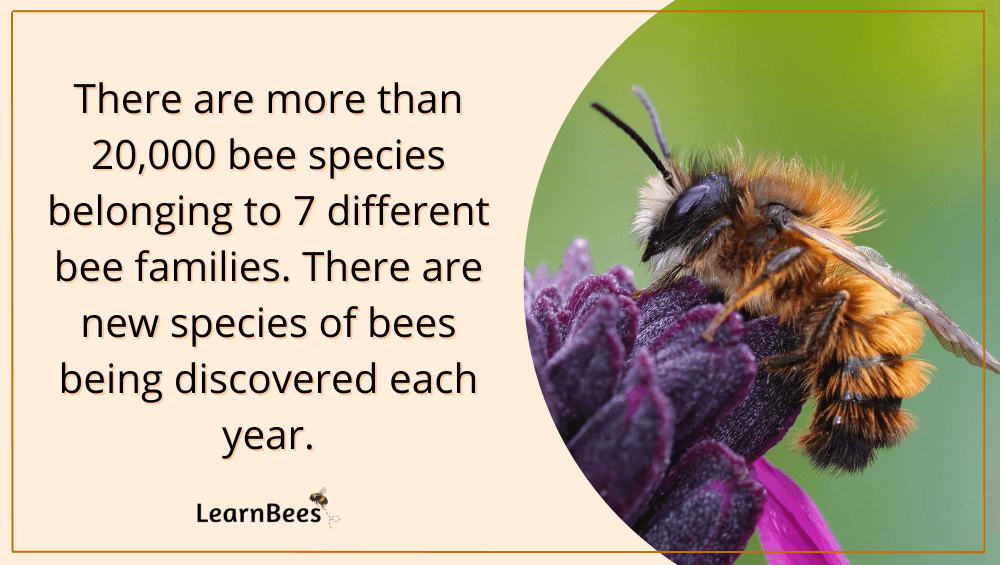
There are more than 20,000 bee species belonging to seven different bee families. The breakdown of each family is as follows:
- Apidae – 6,000 bee species
- Andrenidae – 2,700 bee species
- Colletidae – 2,000 bee species
- Halictidae – 3,500 bee species
- Megachilidae – 3,000 bee species
- Melittidae – 160 bee species
- Stenotritidae – 21 bee species
That said, new bee species are being discovered each year. Some entomologists estimate that there may be well over 30,000 bee species worldwide.
Now you might be wondering…
What is a group of social bees called? For example, a group of honey bees that live together?
A group of bees that live together in a family unit is called a “colony.”
A bee colony typically includes a queen, worker bees (female), and drone bees (male).
But not all bees live in colonies.
Some bees are solitary creatures that live alone. Female solitary bees maintain their nest without help from other bees. Examples of solitary bees include mason bees and carpenter bees.
In contrast?
Honey bees and bumble bees are two common examples of social bees. They live together as brothers and sisters, working and ensuring the colony’s survival.
FAQs About Families of Bees
- Do bees have families?
- What family of insects are bees in?
- What are the 7 families of bees in the world?
- What are the 5 families of bees?
- What is the largest family of bees?
- What is the smallest family of bees?
- What is a large group of bees called?
- What is a colony of bees called?
- What is the order and family of bees?
- Are hornets in the bee family?
- Are honey bees and wasps in the same family?
- Are all bees in a hive siblings?
- What family are honey bees in?
Do bees have families?
Yes, some bees have “families.” Depending on the bee species, they can live in a family unit, or they may be solitary bees that live alone.
For instance, honey bees and bumble bees are social bees that live in colonies. Meanwhile, mason bees and leafcutter bees are solitary creatures that maintain their nest without help from other bees.
Social bees include a queen bee, worker bees, and drone bees. The queen bee is the colony’s mother, while the worker bees (female) and drone bees (male) are siblings.
Additionally, seven families of bees are found worldwide, including Apidae, Andrenidae, Colletidae, Halictidae, Megachilidae, Melittidae, and Stenotritidae.
The families of bees vary in size and distribution. For instance, Apidae is the largest family of bees, with over 6,000 species found worldwide, while Stenotritidae is the smallest family of bees, with only 21 species found in Australia.
—> Go back to the FAQs on families of bees
What family of insects are bees in?
Hymenoptera is the group of insects that bees belong to. This family contains all species of ants, bees, and wasps.
There are more than 150,000 species of Hymenoptera around the world. Of these, bees make up more than 20,000 species across seven families. These families include Apidae (6,000 species), Andrenidae (2,700 species), Colletidae (2,000 species), Halictidae (3,500 species), Megachilidae (3,000 species), Melittidae (160 species), and Stenotritidae (21 species).
Additionally, some bee species have gone extinct over time, while new species are being discovered yearly. Consequently, there may be well over 30,000 bee species worldwide.
—> Go back to the FAQs on families of bees
What are the 7 families of bees in the world?
The seven families of bees in the world are Apidae, Andrenidae, Colletidae, Halictidae, Megachilidae, Melittidae, and Stenotritidae.
Apidae is the largest family of bees, with about 6,000 species found worldwide. This family includes honey bees, bumblebees, and carpenter bees.
Andrenidae is a family of bees with about 2,700 species around the world.
Colletidae contains approximately 2,000 species of “plasterer” or “polyester” bees.
Halictidae is a family of bees with an estimated 3,500 species found worldwide. This family contains sweat bees. The name “sweat bee” comes from their attraction to the salt in human sweat.
Megachilidae is a family of bees with around 3,000 species worldwide. This family includes mason bees and leafcutter bees.
Melittidae contains approximately 160 species of melittid or floral oil-collecting bees worldwide.
Stenotritidae is the smallest family of bees, with only 21 species found in Australia. These bees are known for their ability to fly fast.
—> Go back to the FAQs on families of bees
More to Explore:
What are the 5 families of bees?
There are more than five families of bees. There are actually seven families of bees found around the world. The seven families of bees are Apidae, Andrenidae, Colletidae, Halictidae, Megachilidae, Melittidae, and Stenotritidae.
—> Go back to the FAQs on families of bees
More to Explore:
- Do Wasps Make Honey?
- What’s the Difference Between Wasps, Hornets, and Bees?
- Wasp Nest vs. Bee Nest: Which One Is It?
What is the largest family of bees?
The Apidae family is the largest family of bees in the world. There are over 6,000 different types of bees in this family. They can be found in many other places worldwide, including North America, South America, Asia, Europe, Africa, and Australia.
The most widely recognized bees in the Apidae family are honey bees, bumble bees, and carpenter bees. These bees are essential for the pollination of many crops and other plants. They also produce honey, which is a valuable food source for humans and animals.
—> Go back to the FAQs on families of bees
More to Explore:
- Wasps vs. Honey Bees: Are They Different?
- Are Worker Bees Male or Female?
- Queen Bee Versus Worker Bees – How Do They Compare?
What is the smallest family of bees?
The Stenotritidae family is the smallest family of bees in the world, with only 21 species found in Australia. These bees are known for their ability to fly fast. They are also particularly adapted to living in arid, dry environments, which is why they are only found in Australia.
These bees gather pollen from native plants and help pollinate them as well. Without these essential bees, many of the native plants found in Australia would be greatly reduced.
Therefore, protecting and conserving these bees is important to maintain a healthy and diverse ecosystem.
The Stenotritidae family is one of the many families of bees that show us how important it is for us to preserve our pollinator populations. These vital species play an essential role in maintaining a balanced environment.
—> Go back to the FAQs on families of bees
More to Explore:
- What Are Black and Yellow Wasps?
- How Long Do Bumble Bees Live?
- Honeybees vs. Bumblebees: How Do They Compare?
What is a large group of bees called?
A large group of bees is typically called a “colony” or “swarm.” However, these terms don’t mean the same thing.
A bee colony is a group of bees that live together in a nest, typically led by one queen bee. In the colony, there are worker bees and drones.
A bee swarm is a group of bees that have left their nest and are searching for a new home. The swarm is made up of the queen bee and many worker bees. Swarming is an instinct of honey bees and is a way to reproduce.
The swarm will eventually land on something, forming a cluster, and then the scout bees lead them to their new home.
—> Go back to the FAQs on families of bees
More to Explore:
What is a colony of bees called?
A colony of bees is simply called a “colony” or “beehive.” Social bees, like honey bees, can live in manmade structures managed by beekeepers. These manmade structures are known as beehives.
Beehives are typically made of wood and can come in various shapes and sizes. They provide shelter and protection for the bees.
—> Go back to the FAQs on families of bees
More to Explore:
What is the order and family of bees?
Bees belong to the order Hymenoptera, and the family they belong to depends on the bee species. There are seven different types of bee families.
—> Go back to the FAQs on families of bees
More to Explore:
Are hornets in the bee family?
No, hornets and bees don’t belong to the same family. They’re closely related and belong to the order Hymenoptera, however.
—> Go back to the FAQs on families of bees
More to Explore:
Are honey bees and wasps in the same family?
No, honey bees and wasps are not in the same family. Honey bees belong to the Apidae family, while wasps belong to certain wasp families, depending on the wasp species.
—> Go back to the FAQs on families of bees
More to Explore:
Are all bees in a hive siblings?
The worker and drone bees that live in a colony are siblings, while the queen bee is the mother.
—> Go back to the FAQs on families of bees
More to Explore:
What family are honey bees in?
Honey bees belong to the Apidae family. This is the largest family of bees and includes many different types, such as squash bees, orchid bees, stingless bees, and long-horned bees.
